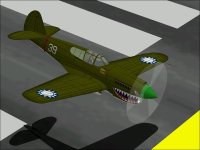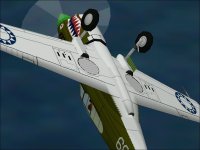Template Parts and Checking Alignment
We got back from vacation this weekend.
While on vacation, I had quite a bit of time to look for photographs of the P-40 and found quite a few though I did not have the capability to actually do any modifications to my project.
One of the things I noticed was that the P-40 actually had a wing tip with a flat underside and I had missed that completely in my model. This is actually a very easy and quick fix which I did the night we got back.
Other changes have been from starting from the wing trailing edge and moving forward. (I believe I have completed everything behind the wing.) My process here is to rework the reference parts (the equivalent of Jigs and Fixtures) while checking how they align with other existing pieces and THEIR Templates which may also get reworked.
An interesting thing to observe is the relationship between the cowl fairing on the bottom of the fuselage and the line of the lower fuselage as it continues back to the rudder. On the real aircraft, the underside of fuselage at the cockpit is where the two wings are joined to be covered by a fairing. On my model, this line is just imaginary because there are no actual polygons under the fairing. The light blue reference part shows a fairly consistent line between the tail and the cowl and is used to confirm that the polygons forming the wings are aligned with the wing fillet polygons and their projected endpoints are in alignment at the fuselage centerline. The cowl fairing polygons must also meet along the projected line.
Next step is to rebuild the front half of the Warhawk....
- Ivan.
We got back from vacation this weekend.
While on vacation, I had quite a bit of time to look for photographs of the P-40 and found quite a few though I did not have the capability to actually do any modifications to my project.
One of the things I noticed was that the P-40 actually had a wing tip with a flat underside and I had missed that completely in my model. This is actually a very easy and quick fix which I did the night we got back.
Other changes have been from starting from the wing trailing edge and moving forward. (I believe I have completed everything behind the wing.) My process here is to rework the reference parts (the equivalent of Jigs and Fixtures) while checking how they align with other existing pieces and THEIR Templates which may also get reworked.
An interesting thing to observe is the relationship between the cowl fairing on the bottom of the fuselage and the line of the lower fuselage as it continues back to the rudder. On the real aircraft, the underside of fuselage at the cockpit is where the two wings are joined to be covered by a fairing. On my model, this line is just imaginary because there are no actual polygons under the fairing. The light blue reference part shows a fairly consistent line between the tail and the cowl and is used to confirm that the polygons forming the wings are aligned with the wing fillet polygons and their projected endpoints are in alignment at the fuselage centerline. The cowl fairing polygons must also meet along the projected line.
Next step is to rebuild the front half of the Warhawk....
- Ivan.






















